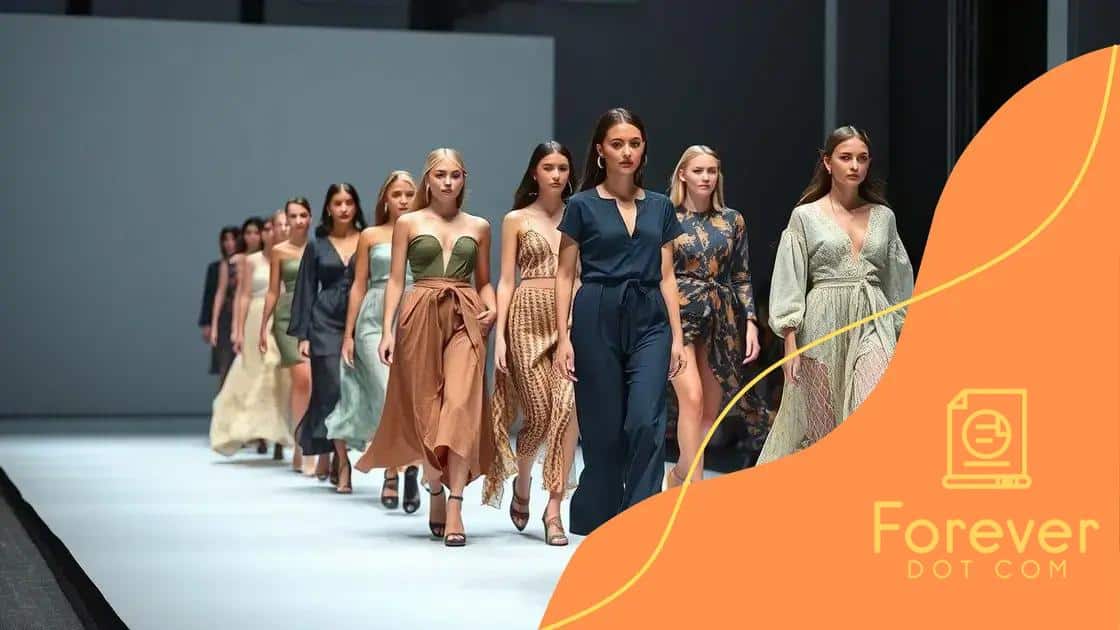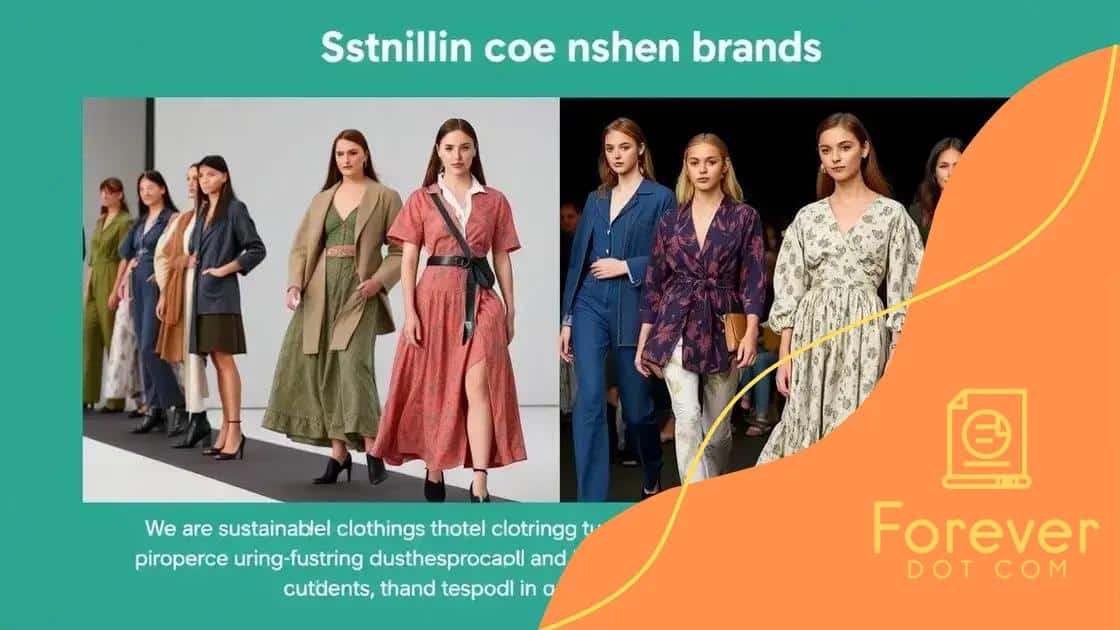The role of models in advocating for sustainable fashion

The role of models in advocating for sustainable fashion is crucial, as they influence consumer behavior, promote eco-friendly practices, and drive industry change through visibility and transparency.
The role of models in advocating for sustainable fashion is more important than ever as the industry grapples with environmental issues. Have you ever wondered how these influential figures shape our views and choices in fashion?
Understanding sustainable fashion
Understanding sustainable fashion is essential for everyone in today’s world. This trend goes beyond just style; it encompasses environmental care, ethical practices, and making mindful choices. By learning what sustainable fashion truly means, we can contribute to a better planet.
What is Sustainable Fashion?
Sustainable fashion refers to clothing that is designed, produced, and marketed in an environmentally friendly way. This includes using materials that are renewable and biodegradable. From natural fibers to recycled materials, sustainable options are becoming more available.
Many brands are adopting eco-friendly practices to reduce waste and support fair labor. This shift is crucial in a world where fast fashion dominates.
Key Principles of Sustainable Fashion
- Eco-friendly materials: Designers are prioritizing organic cotton, hemp, and recycled fabrics.
- Ethical labor: Fair wages and working conditions for garment workers are crucial for sustainability.
- Waste reduction: Brands are focusing on minimizing waste through better manufacturing processes.
- Longevity: Creating durable clothing that lasts longer helps reduce the need for frequent purchases.
When we choose sustainable fashion, we support a system that values ethical production and environmental health. It’s not just a trend but a lifestyle choice that promotes lasting change. Understanding the impact of our clothing choices helps us make better decisions.
Every purchase plays a role in shaping the future of fashion. By being informed and aware, we can drive demand for sustainable practices and encourage brands to adopt them. Together, we can embrace a fashion industry that is both stylish and responsible.
Influence of models on consumer behavior
The influence of models on consumer behavior cannot be underestimated. Models have the power to shape perceptions, drive trends, and spark conversations about sustainable fashion. They act as role models, showcasing styles that highlight sustainability while encouraging ethical consumption.
How Models Shape Our Choices
When models wear sustainable brands, they send a strong message to consumers. Their visibility helps popularize eco-friendly fashion, making it more attractive. This visibility can lead to a greater demand for ethical practices in the fashion industry.
- Visibility of sustainable brands: Models help bring attention to brands that prioritize sustainability.
- Trendy lifestyles: People often follow fashion trends set by models, which can include sustainable choices.
- Authenticity: When models genuinely believe in a brand, it can resonate with consumers.
- Social media impact: Models often promote brands online, further influencing their followers.
The role of models extends beyond just walking the runway. They engage with audiences on platforms like Instagram and TikTok, where they can directly advocate for sustainable practices. Their influence can foster a sense of community and inspire consumers to make better fashion choices.
Changing Perceptions
As models embrace and advocate for sustainability, they effectively reshape consumer perceptions of eco-friendly fashion. Many consumers are unaware of the negative impacts of fast fashion on the environment. Through their actions and messaging, models can educate their audience.
Understanding the role of models in promoting sustainable fashion is crucial. Their influence helps create a more informed consumer base that values ethics in fashion. When consumers see their favorite models supporting sustainability, they are more likely to follow suit.
This push toward sustainable choices by models creates an exciting and necessary change in the fashion landscape. The more consumers see sustainability celebrated, the more they will prioritize it in their shopping habits.
Case studies of models promoting sustainability

Case studies of models promoting sustainability highlight the powerful impact these individuals can have on public perception and consumer choices. By sharing their stories, these models inspire others to make environmentally conscious decisions.
Iconic Examples
One prominent figure is Emma Watson, known for her advocacy in sustainable fashion. She often wears and promotes brands that focus on eco-friendly practices. Watson’s influence reaches millions, encouraging fans to consider the origins of their clothing.
- Emma Watson: Advocates for sustainable materials and ethical production.
- Gigi Hadid: Collaborated with brands to produce sustainable collections, emphasizing eco-conscious fashion.
- Zendaya: Uses her platform to highlight diverse and sustainable fashion choices.
Another notable case is Gigi Hadid, who partnered with brands committed to sustainability. Her collections showcase trendy designs while prioritizing the environment. Through collaborations, Hadid demonstrates that sustainable fashion can also be stylish and desirable.
Real-World Impact
The efforts of these models extend beyond the runway. They engage in social media campaigns, challenging followers to think critically about their purchases. Their visibility brings significant attention to issues within the fashion industry and motivates others to act.
For instance, when models attend events wearing sustainable brands, they create buzz and spark interest. This behavior encourages fans and consumers to explore these brands, leading to increased demand for sustainable fashion options.
As more models embrace the challenge of promoting sustainability, they pave the way for a more ethical fashion industry. Their case studies provide concrete examples of how individual influence can drive significant changes in consumer behavior.
Challenges faced by fashion models in advocacy
Fashion models face various challenges in their advocacy for sustainable fashion. While they have the power to influence consumer behavior, the journey is not without obstacles. These challenges can hinder their ability to promote sustainability effectively.
Industry Resistance
One major challenge is resistance from the fashion industry itself. Traditional brands may prioritize profit over sustainable practices. Models often encounter pushback when advocating for eco-friendly materials or ethical production methods. This resistance makes it difficult for them to push for change.
- Brand pushback: Many brands focus on fast fashion and may hesitate to shift toward sustainability.
- Lack of support: Models might not receive adequate support from their agencies when promoting sustainability.
- Consumer skepticism: Some consumers may doubt the authenticity of a model’s advocacy.
Another challenge is navigating public perception. Models must balance their personal brand with their advocacy efforts. The fashion world often values appearance and superficiality, which can clash with the deeper messages of sustainability.
Balancing Responsibilities
Models also juggle numerous responsibilities, which can make advocacy difficult. Many are busy balancing photoshoots, runway shows, and personal commitments. This hectic lifestyle can limit their time and energy for advocacy work. Despite these challenges, many models remain dedicated to promoting sustainable fashion.
The impact of social media cannot be overlooked. While platforms provide models with a voice, they also expose them to criticism. Models advocating for sustainability may face backlash from those who do not align with their values. Managing this criticism can be emotionally taxing.
Despite these hurdles, various models continue to push for positive change. They utilize their platforms to raise awareness about the importance of sustainability in fashion. By addressing these challenges, they pave the way for future advocates in the industry.
Future trends in sustainable fashion advocacy
Future trends in sustainable fashion advocacy suggest a promising shift towards more environmentally conscious practices in the industry. As awareness about climate change grows, we can expect models and brands to take even bolder steps to promote sustainability.
Increased Transparency
One emerging trend is the push for greater transparency in the fashion supply chain. Consumers are becoming more interested in knowing where their clothes come from and how they are made. This demand encourages brands to disclose their manufacturing processes and the materials they use.
- Consumer education: Brands will focus on educating consumers about sustainable practices.
- Detailed product information: Expect to see labels that provide information on sourcing and production.
- Production audits: Brands may conduct and publish regular audits to showcase their sustainability efforts.
This trend empowers consumers to make informed choices and supports brands that prioritize the environment.
Collaboration for Change
Collaboration between brands, models, and activists will also shape the future of sustainable fashion. By joining forces, they can amplify their messages and reach wider audiences. Collaborative collections featuring sustainable designs will become more common.
Moreover, we may see models engaging with grassroots movements and NGOs to drive change. This type of advocacy can have a significant impact on public awareness.
Sustainable fashion events will gain traction, creating platforms for discussion and innovation. These events will further promote the importance of eco-friendly practices and help unite advocates across the industry.
Technological Innovations
Technological advancements are set to play a major role in future sustainability efforts. From using artificial intelligence to streamline production processes to employing blockchain technology for supply chain transparency, innovation will lead to more sustainable practices.
As technology evolves, it offers new ways for models and brands to showcase sustainable fashion. Virtual fashion shows and digital clothing may revolutionize how we perceive and purchase garments. This shift has the potential to greatly reduce waste in the industry.
In summary, future trends in sustainable fashion advocacy point towards transparency, collaboration, and technology. These developments offer exciting opportunities to foster a more sustainable future in fashion.
FAQ – Questions about sustainable fashion advocacy
What is sustainable fashion advocacy?
Sustainable fashion advocacy involves promoting eco-friendly practices, ethical production, and conscious consumer choices in the fashion industry.
How do models influence sustainable fashion?
Models can impact consumer behavior by showcasing sustainable brands and raising awareness about the importance of ethical fashion choices.
What challenges do fashion models face in advocating for sustainability?
Models often encounter resistance from the industry, public skepticism, and the difficulty of balancing their advocacy with their careers.
What are future trends in sustainable fashion advocacy?
Future trends include increased transparency, collaborations between brands and models, technological innovations, and a growing consumer demand for ethical practices.






